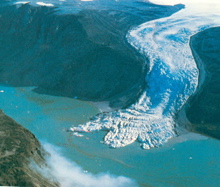Difference between revisions of "Glacier"
m (Text replacement - "http://" to "https://") |
|||
| Line 3: | Line 3: | ||
==Origin== | ==Origin== | ||
French, from Middle French [[dialect]] (Franco-Provençal), from ''glace'' ice, from [[Latin]] ''glacies''; akin to Latin ''gelu'' frost | French, from Middle French [[dialect]] (Franco-Provençal), from ''glace'' ice, from [[Latin]] ''glacies''; akin to Latin ''gelu'' frost | ||
| − | *[ | + | *[https://en.wikipedia.org/wiki/18th_century 1744] |
| − | The processes and features caused by ''glaciers'' and related to them are referred to as ''glacial''. The [[process]] of glacier establishment, [[growth]] and [[flow]] is called ''glaciation''. The corresponding area of [[study]] is called [ | + | The processes and features caused by ''glaciers'' and related to them are referred to as ''glacial''. The [[process]] of glacier establishment, [[growth]] and [[flow]] is called ''glaciation''. The corresponding area of [[study]] is called [https://en.wikipedia.org/wiki/Glaciology glaciology]. Glaciers are important components of the global [https://en.wikipedia.org/wiki/Cryosphere cryosphere]. |
==Definitions== | ==Definitions== | ||
*1: a large body of ice moving slowly down a slope or [[valley]] or spreading outward on a [[land]] surface | *1: a large body of ice moving slowly down a slope or [[valley]] or spreading outward on a [[land]] surface | ||
==Description== | ==Description== | ||
| − | A '''glacier''' is a large [[persistent]] body of ice that forms where the accumulation of snow exceeds its [ | + | A '''glacier''' is a large [[persistent]] body of ice that forms where the accumulation of snow exceeds its [https://en.wikipedia.org/wiki/Ablation ablation] (melting and sublimation) over many years, often centuries. Glaciers slowly deform and flow due to [[stresses]] induced by their weight, creating [https://en.wikipedia.org/wiki/Crevasse crevasses], [https://en.wikipedia.org/wiki/Serac seracs], and other distinguishing features. They also abrade rock and debris from their substrate to create landforms such as [https://en.wikipedia.org/wiki/Cirque cirques] and [https://en.wikipedia.org/wiki/Moraine moraines]. Glaciers form only on land and are distinct from the much thinner [https://en.wikipedia.org/wiki/Sea_ice sea ice] and lake ice that form on the surface of bodies of [[water]]. |
| − | On [[Earth]], 99% of glacial ice is contained within vast ice sheets in the [ | + | On [[Earth]], 99% of glacial ice is contained within vast ice sheets in the [https://en.wikipedia.org/wiki/Polar_region polar regions], but glaciers may be found in [[mountain]] ranges of every [[continent]] except Australia, and on a few high-latitude [https://en.wikipedia.org/wiki/Oceanic_island oceanic islands]. Between 35°N and 35°S, glaciers occur only in the [https://en.wikipedia.org/wiki/Himalayas Himalayas], [https://en.wikipedia.org/wiki/Andes Andes], a few high mountains in East Africa, Mexico, New Guinea and on [https://en.wikipedia.org/wiki/Zard_Kuh Zard Kuh in Iran]. |
| − | Glacial ice is the largest reservoir of [ | + | Glacial ice is the largest reservoir of [https://en.wikipedia.org/wiki/Freshwater freshwater] on Earth, supporting one third of the world's [[population]]. Many glaciers store water during one [[season]] and release it later as meltwater, a water source that is especially important for [[plants]], [[animals]] and [[human]] uses when other sources may be scant. |
| − | Because glacial mass is affected by long-term [[climate]] changes, e.g., precipitation, mean temperature, and cloud cover, glacial mass [[changes]] are considered among the most [[sensitive]] indicators of [ | + | Because glacial mass is affected by long-term [[climate]] changes, e.g., precipitation, mean temperature, and cloud cover, glacial mass [[changes]] are considered among the most [[sensitive]] indicators of [https://en.wikipedia.org/wiki/Climate_change climate change] and are a major source of variations in [https://en.wikipedia.org/wiki/Current_sea_level_rise sea level].[https://en.wikipedia.org/wiki/Glacier] |
[[Category: Earth Science]] | [[Category: Earth Science]] | ||
Latest revision as of 00:36, 13 December 2020
Origin
French, from Middle French dialect (Franco-Provençal), from glace ice, from Latin glacies; akin to Latin gelu frost
The processes and features caused by glaciers and related to them are referred to as glacial. The process of glacier establishment, growth and flow is called glaciation. The corresponding area of study is called glaciology. Glaciers are important components of the global cryosphere.
Definitions
Description
A glacier is a large persistent body of ice that forms where the accumulation of snow exceeds its ablation (melting and sublimation) over many years, often centuries. Glaciers slowly deform and flow due to stresses induced by their weight, creating crevasses, seracs, and other distinguishing features. They also abrade rock and debris from their substrate to create landforms such as cirques and moraines. Glaciers form only on land and are distinct from the much thinner sea ice and lake ice that form on the surface of bodies of water.
On Earth, 99% of glacial ice is contained within vast ice sheets in the polar regions, but glaciers may be found in mountain ranges of every continent except Australia, and on a few high-latitude oceanic islands. Between 35°N and 35°S, glaciers occur only in the Himalayas, Andes, a few high mountains in East Africa, Mexico, New Guinea and on Zard Kuh in Iran.
Glacial ice is the largest reservoir of freshwater on Earth, supporting one third of the world's population. Many glaciers store water during one season and release it later as meltwater, a water source that is especially important for plants, animals and human uses when other sources may be scant.
Because glacial mass is affected by long-term climate changes, e.g., precipitation, mean temperature, and cloud cover, glacial mass changes are considered among the most sensitive indicators of climate change and are a major source of variations in sea level.[1]
